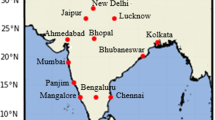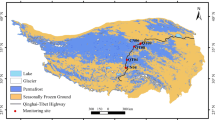Abstract
With the expansion of science and technology worldwide, various satellite products of meteorological parameters have been developed, which can compensate for the lack of observational data. However, to use these products effectively, their accuracy needs to be verified. Therefore, this study investigates the precision of NASA POWER satellite minimum and maximum air temperature data in 70 synoptic stations in Iran from 1987 to 2018. The study examines the data on three-time scales, with 0.5 degree spatial resolution. The findings indicate that the degree of exactness in the NASA POWER temperature data was greater during the monthly interval. The performance of the minimum and maximum air temperature data of the NASA POWER database has been relatively constant in different latitudes. However, changes in the performance of NASA POWER products in stations with different altitudes indicate that the performance of maximum air temperature is better in stations with an altitude of > 1900 m.a.s.l. On the other hand, altitude greatly affects the accuracy of the performance of the satellite model's maximum air temperature. On a daily and monthly time scale, altitude does not significantly impact the minimum temperature data, but on an annual scale, NASA POWER products perform better at low-altitude stations. Hence, the RMSE error values are lower in stations with an altitude of 400–700 m.a.s.l (RMSE = 2.8 °C) than in stations with an altitude of > 1900 m.a.s.l (RMSE = 6.9 °C). NASA-POWER products perform better in summer than in winter. The RMSE error values in the hot months of the year were between 2.64 and 2.81 °C all over Iran, while the minimum temperature in the cold months of the year was between 6.26 and 7.48 °C, which is significantly different. The research also showed that NASA POWER data are more accurate at maximum temperature than at minimum temperature, and these products have less accuracy at minimum temperatures in cold regions. Additionally, the results showed that the error rate in minimum and maximum data in dry and hot regions was less than in other regions, and this satellite product had a more acceptable performance in detecting the temperature of hot and desert regions. The investigation of diverse return periods of minimum and maximum air temperatures elucidates that in arid and parched areas, the maximum air temperature escalates as the return period amplifies; conversely, in hilly and moist regions, the minimum air temperature heightens with the upsurge of the return period. The consequences garnered from this exploration can be employed in meteorological and climatologic analyses and drought inquiries.










Similar content being viewed by others
Data availability
Please contact the corresponding author for data requests.
Code availability
Please contact the corresponding author for code requests.
References
Aboelkhair H, Morsy M, El Afandi G (2019) Assessment of agroclimatology NASA POWER reanalysis datasets for temperature types and relative humidity at 2 m against ground observations over Egypt. Adv Space Res 64(1):129–142. https://doi.org/10.1016/j.asr.2019.03.032
Al-Kilani MR, Rahbeh M, Al-Bakri J, Tadesse T, Knutson C (2021) Evaluation of remotely sensed precipitation estimates from the NASA POWER project for drought detection over Jordan. Earth Syst Environ 5(3):561–573. https://doi.org/10.1007/S41748-021-00245-2/METRICS
Alexandersson H (1986) A homogeneity test applied to precipitation data. J Climatol 6(6):661–675. https://doi.org/10.1002/JOC.3370060607
Alijanian M, Rakhshandehroo GR, Mishra AK, Dehghani M, Alijanian M, Rakhshandehroo GR, Mishra AK, Dehghani M (2017) Evaluation of satellite rainfall climatology using CMORPH, PERSIANN-CDR, PERSIANN, TRMM. MSWEP over Iran Ijcli 37(14):4896–4914. https://doi.org/10.1002/JOC.5131
Bai J, Chen X, Dobermann A, Yang H, Cassman KG, Zhang F (2010) Evaluation of NASA satellite-and model-derived weather data for simulation of maize yield potential in China. Agron J. https://doi.org/10.2134/agronj2009.0085
Bao X, Zhang F (2013) Evaluation of NCEP–CFSR, NCEP–NCAR, ERA-Interim, and ERA-40 reanalysis datasets against independent sounding observations over the Tibetan Plateau. J Clim 26(1):206–214. https://doi.org/10.1175/JCLI-D-12-00056.1
Bonnet R, Boé J, Habets F (2020) Influence of multidecadal variability on high and low flows: the case of the Seine basin. Hydrol Earth Syst Sci 24(4):1611–1631. https://doi.org/10.5194/HESS-24-1611-2020
Chandler WS (2011) NASA’s prediction of worldwide energy resource (POWER) web services. AMS
Chen G, Iwasaki T, Qin H, Sha W (2014) Evaluation of the Warm-Season Diurnal Variability over East Asia in Recent Reanalyses JRA-55, ERA-Interim, NCEP CFSR, and NASA MERRA. J Clim 27(14):5517–5537. https://doi.org/10.1175/JCLI-D-14-00005.1
Chen S, Gan TY, Tan X, Shao D, Zhu J (2019) Assessment of CFSR, ERA-Interim, JRA-55, MERRA-2, NCEP-2 reanalysis data for drought analysis over China. Clim Dyn 53(1):737–757. https://doi.org/10.1007/S00382-018-04611-1
Dee DP, Uppala SM, Simmons AJ, Berrisford P, Poli P, Kobayashi S, Andrae U, Balmaseda MA, Balsamo G, Bauer P, Bechtold P, Beljaars ACM, van de Berg L, Bidlot J, Bormann N, Delsol C, Dragani R, Fuentes M, Geer AJ, Vitart F (2011) The ERA-Interim reanalysis: configuration and performance of the data assimilation system. Q J R Meteorol Soc 137(656):553–597. https://doi.org/10.1002/QJ.828
Drapera CS, Reichle RH, Koster RD (2018) Assessment of MERRA-2 land surface energy flux estimates. J Clim 31(2):671–691. https://doi.org/10.1175/JCLI-D-17-0121.1
Hanus S, Hrachowitz M, Zekollari H, Schoups G, Vizcaino M, Kaitna R (2021) Future changes in annual, seasonal and monthly runoff signatures in contrasting alpine catchments in Austria. Hydrol Earth Syst Sci 25(6):3429–3453. https://doi.org/10.5194/HESS-25-3429-2021
Hazra A, Maggioni V, Houser P, Antil H, Noonan M (2019) A Monte Carlo-based multi-objective optimization approach to merge different precipitation estimates for land surface modeling. J Hydrol 570(454):462. https://doi.org/10.1016/j.jhydrol.2018.12.039
Kadhim Tayyeh H, Mohammed R (2023) Analysis of NASA POWER reanalysis products to predict temperature and precipitation in Euphrates river basin. J Hydrol 619:129327. https://doi.org/10.1016/j.jhydrol.2023.129327
Kanamitsu M, Ebisuzaki W, Woollen J, Yang SK, Hnilo JJ, Fiorino M, Potter GL (2002) NCEP–DOE AMIP-II reanalysis (R-2). Bull Am Meteor Soc 83(11):1631–1644. https://doi.org/10.1175/BAMS-83-11-1631
Kheyruri Y, Nikaein E, Sharafati A (2023a) Spatial monitoring of meteorological drought characteristics based on the NASA POWER precipitation product over various regions of Iran. Environ Sci Pollut Res 2023:1–22. https://doi.org/10.1007/S11356-023-25283-3
Kheyruri Y, Sharafati A (2022) Spatiotemporal assessment of the NASA POWER satellite precipitation product over different regions of Iran. Pure Appl Geophys 2022:1–13. https://doi.org/10.1007/S00024-022-03133-6
Kheyruri Y, Sharafati A, Shahid S (2023b) Evaluation of the impact of large-scale atmospheric indicators and meteorological variables on drought in different regions of Iran. Environ Earth Sci. https://doi.org/10.1007/S12665-023-11015-W
Kobayashi S, Ota Y, Harada Y, Ebita A, Moriya M, Onoda H, Onogi K, Kamahori H, Kobayashi C, Endo H, Miyaoka K, Kiyotoshi T (2015) The JRA-55 reanalysis: general specifications and basic characteristics. J Meteorol Soc Japan Ser II 93(1):5–48. https://doi.org/10.2151/JMSJ.2015-001
Legates DR, McCabe GJ (1999) Evaluating the use of “goodness-of-fit” measures in hydrologic and hydroclimatic model validation. Water Resour Res 35(1):233–241. https://doi.org/10.1029/1998WR900018
Mary SR, Zaal MH, Pour MH (2022) Factors in the formation of visitor’s environmentally responsible behavior (ERB) in damavand mountain Iran. J Ecotourism. https://doi.org/10.1080/14724049.2022.2147939
Marzouk OA (2021) Assessment of global warming in Al Buraimi, sultanate of Oman based on statistical analysis of NASA POWER data over 39 years, and testing the reliability of NASA POWER against meteorological measurements. Heliyon 7(3):e06625. https://doi.org/10.1016/J.HELIYON.2021.E06625
Maurer EP, O’Donnell GM, Lettenmaier DP, Roads JO (2001) Evaluation of the land surface water budget in NCEP/NCAR and NCEP/DOE reanalyses using an off-line hydrologic model. J Geophys Res: Atmos 106(D16):17841–17862. https://doi.org/10.1029/2000JD900828
Modarres R (2006) Regional precipitation climates of Iran. J Hydrol 45(1):15
Monteiro LA, Sentelhas PC, Pedra GU (2018) Assessment of NASA/POWER satellite-based weather system for Brazilian conditions and its impact on sugarcane yield simulation. Int J Climatol 38(3):1571–1581. https://doi.org/10.1002/JOC.5282
Muelchi R, Rössler O, Schwanbeck J, Weingartner R, Martius O (2021) River runoff in Switzerland in a changing climate—changes in moderate extremes and their seasonality. Hydrol Earth Syst Sci 25(6):3577–3594. https://doi.org/10.5194/HESS-25-3577-2021
Negm A, Jabro J, Provenzano G (2017) Assessing the suitability of American national aeronautics and space administration (NASA) agro-climatology archive to predict daily meteorological variables and reference evapotranspiration in Sicily, Italy. Agric for Meteorol 244–245:111–121. https://doi.org/10.1016/J.AGRFORMET.2017.05.022
Reichle RH, Draper CS, Liu Q, Girotto M, Mahanama SPP, Koster RD, De Lannoy GJM (2017) Assessment of MERRA-2 land surface hydrology estimates. J Clim 30(8):2937–2960. https://doi.org/10.1175/JCLI-D-16-0720.1
Rienecker MM, Suarez MJ, Gelaro R, Todling R, Bacmeister J, Liu E, Bosilovich MG, Schubert SD, Takacs L, Kim GK, Bloom S, Chen J, Collins D, Conaty A, Da Silva A, Gu W, Joiner J, Koster RD, Lucchesi R, Woollen J (2011) MERRA: NASA’s modern-era retrospective analysis for research and applications. J Clim 24(14):3624–3648. https://doi.org/10.1175/JCLI-D-11-00015.1
Ringard J, Chiriaco M, Bastin S, Habets F (2019) Recent trends in climate variability at the local scale using 40 years of observations: the case of the Paris region of France. Atmos Chem Phys 19(20):13129–13155. https://doi.org/10.5194/ACP-19-13129-2019
Rockett PL, Campos IL, Baes CF, Tulpan D, Miglior F, Schenkel FS (2023) Phenotypic analysis of heat stress in Holsteins using test-day production records and NASA POWER meteorological data. J Dairy Sci 106(2):1142–1158. https://doi.org/10.3168/JDS.2022-22370
Rodrigues GC, Braga RP (2021) Evaluation of nasa power reanalysis products to estimate daily weather variables in a hot summer mediterranean climate. Agronomy 11(6):1207. https://doi.org/10.3390/AGRONOMY11061207/S1
Rodrigues GC, Braga RP, Gonçalves M (2021) Evaluation of NASA POWER reanalysis products to estimate daily weather variables in a hot summer mediterranean climate. Agronomy. https://doi.org/10.3390/agronomy11061207
Saha A, Pal SC, Chowdhuri I, Roy P, Chakrabortty R, Shit M (2022) Vulnerability assessment of drought in India: Insights from meteorological, hydrological, agricultural and socio-economic perspectives. Gondwana Res. https://doi.org/10.1016/J.GR.2022.11.006
Schneider DP, Deser C, Fasullo J, Trenberth KE (2013) Climate data guide spurs discovery and understanding. EOS Trans Am Geophys Union 94(13):121–122. https://doi.org/10.1002/2013EO130001
Sheffield J, Ziegler AD, Wood EF, Chen Y (2004) Correction of the high-latitude rain day anomaly in the NCEP NCAR reanalysis for land surface hydrological modeling. J Clim 17(19):3814–3828. https://doi.org/10.1175/1520-0442(2004)017
Shiau J-T, Shen HW (2001) Recurrence analysis of hydrologic droughts of differing severity. J Water Resour Plan Manag 127(1):30–40. https://doi.org/10.1061/(ASCE)0733-9496(2001)127:1(30)
Shiau JT, Wang HY, Tsai CT (2006) Bivariate frequency analysis of floods using copulas1. JAWRA J Am Water Resour Assoc 42(6):1549–1564. https://doi.org/10.1111/J.1752-1688.2006.TB06020.X
Strohmenger L, Ackerer P, Belfort B, Pierret MC (2022) Local and seasonal climate change and its influence on the hydrological cycle in a mountainous forested catchment. J Hydrol 610:127914. https://doi.org/10.1016/J.JHYDROL.2022.127914
Strohmenger L, Fovet O, Akkal-Corfini N, Dupas R, Durand P, Faucheux M, Gruau G, Hamon Y, Jaffrezic A, Minaudo C, Petitjean P, Gascuel-Odoux C (2020) Multitemporal relationships between the hydroclimate and exports of carbon, nitrogen, and phosphorus in a small agricultural watershed. Water Resour Res 56(7):e2019WR026323. https://doi.org/10.1029/2019WR026323
Trenberth KE, Guillemot CJ (1998) Evaluation of the atmospheric moisture and hydrological cycle in the NCEP/NCAR reanalyses. Clim Dyn 14(3):213–231. https://doi.org/10.1007/S003820050219
Tsujino H, Urakawa S, Nakano H, Small RJ, Kim WM, Yeager SG, Danabasoglu G, Suzuki T, Bamber JL, Bentsen M, Böning CW, Bozec A, Chassignet EP, Curchitser E, Boeira Dias F, Durack PJ, Griffies SM, Harada Y, Ilicak M, Yamazaki D (2018) JRA-55 based surface dataset for driving ocean–sea-ice models (JRA55-do). Ocean Model 130:79–139. https://doi.org/10.1016/J.OCEMOD.2018.07.002
Van Wart J, Grassini P, Yang H, Claessens L, Jarvis A, Cassman KG (2015) Creating long-term weather data from thin air for crop simulation modeling. Agric for Meteorol 209–210:49–58. https://doi.org/10.1016/J.AGRFORMET.2015.02.020
Vicente-Serrano SM, Beguería S, López-Moreno JI (2010) A multiscalar drought index sensitive to global warming: the standardized precipitation evapotranspiration index. J Clim 23(7):1696–1718. https://doi.org/10.1175/2009jcli2909.1
White JW, Hoogenboom G, Stackhouse PW, Hoell JM (2008) Evaluation of NASA satellite- and assimilation model-derived long-term daily temperature data over the continental US. Agric for Meteorol 148(10):1574–1584. https://doi.org/10.1016/J.AGRFORMET.2008.05.017
Acknowledgements
The authors would like to reveal their gratitude and appreciation to the Iranian Meteorological Organization for providing data.
Funding
No funding.
Author information
Authors and Affiliations
Corresponding author
Ethics declarations
Conflict of interest
The authors declare that they have no competing interests.
Ethical approval
Not applicable.
Consent to participate
Not applicable.
Consent for publication
Not applicable.
Additional information
Edited by Prof. Ioannis Pytharoulis (ASSOCIATE EDITOR) / Prof. Theodore Karacostas (CO-EDITOR-IN-CHIEF).
Rights and permissions
Springer Nature or its licensor (e.g. a society or other partner) holds exclusive rights to this article under a publishing agreement with the author(s) or other rightsholder(s); author self-archiving of the accepted manuscript version of this article is solely governed by the terms of such publishing agreement and applicable law.
About this article
Cite this article
Kheyruri, Y., Sharafati, A. & Ahmadi Lavin, J. Performance assessment of NASA POWER temperature product with different time scales in Iran. Acta Geophys. 72, 1175–1189 (2024). https://doi.org/10.1007/s11600-023-01186-2
Received:
Accepted:
Published:
Issue Date:
DOI: https://doi.org/10.1007/s11600-023-01186-2




